Metallurgy
Hopewell gold, silver, copper, and meteoric iron artifacts have been verified by modern day archeologist. Listed below are pictures of confirmed Hopewell artifacts and accounts of early settlers.
“Ornate plates or sheets of copper (Figure 7), as well as effigies, headdresses (Figure 8), bracelets, and rings were found in the mound but not at the other selected sites. Figure 9 provides an example of one of the ornaments from the copper deposit in Mound 25. Even within the category of copper cutouts or sheets, great variety was present in the specific shapes and forms. Animals such as birds or fish were represented, as were geometric or other more abstract forms, such as swastikas. However, types such as celts, beads, bear teeth of copper, breastplates, and buttons were common to other sites. Moorehead (1922:118) lists a copper awl as coming from Mound 25, but this awl is not listed in Greber and Ruhl (1989) or Case and Carr (2008:Appendices 6.1A, 6.2).”
(In reference to mound ruins)
“Besides, had the people who raised these works, been in possession of, and used ever so many tools, manufactured from iron, by lying either on or under the earth, during all that long period which has intervened between their authors and us, they would have long since oxydized by “rusting,” and left but faint traces of their existence behind them.”
(Atwater 1833 pg. 140)
(In reference to Hopewell ruins)
“Gold and silver ornaments have been found in many of the tumuli (mounds) in Ohio. Silver very well plated, has been found in several of the mounds : copper in many: pipe bowls of copper, hammered, and not welded together, but lapped over, have been found in them.”
(Haywood 1823 pg. 343)
Hopewell silver earspools artifacts
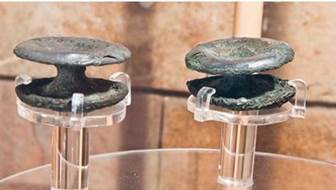
Hopewell copper bracelet
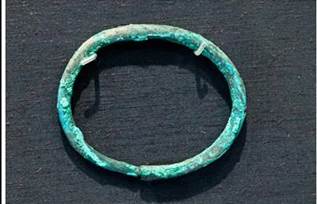
Smelting
Archeologist have not confirmed smelting by Hopewell Indians they have only speculated. Early settlers found ancient Indian furnaces and iron swords and tools that could have only been made by smelting. The Hopewell Mann site has given anthropologist another look of ancient smelting. The furnaces that anthropologist have found are believed to have been tampered with. It is no doubt the Hopewell and Adena Indians were excellent metal smiths and used heat to manipulated metal into tools and weapons.
“That may be answered in the last, and perhaps the most remarkable discovery at Mann. Linderman says scientists are starting tests on what appears to be evidence of lead smelting. The practice of melting metals at a very high temperature is just one of the many questions archaeologists will be confronting.”
(In reference to Hopewell ruins)
“There appears to have been a row of furnaces or smiths’ shops, where the cinders now lie many feet in depth. The remains are four or five feet in depth even now in many places.”
(Haywood 1823 pg. 349)
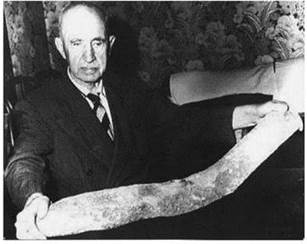
Arlington Mallery excavated a long tube of iron slag from an Adena site in the Ohio Valley.
Breastplate/Head Plate Artifacts
Today’s anthropologist have found copper breast Plates and head plates metal jewelry and knifes. Pictured below are Hopewell Indian breastplates and dig that found 92 copper and Iron breastplates found still positioned on top of skeletons.
“Discovered with a Skeleton, near Fall River, Massachusetts, in the year 1831. With this skeleton were found a corroded plate of brass, supposed to have constituted a breastplate.”
(Squier 1849)

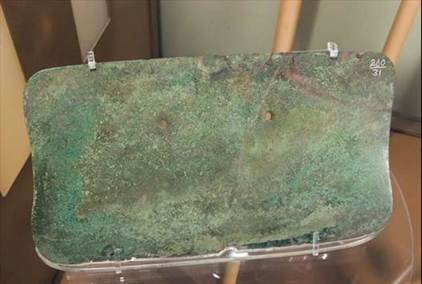
Breast plate with pearl necklace
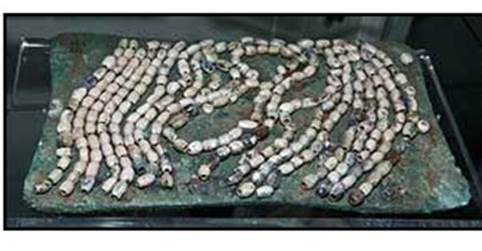
Hopewell Head plate artifact:
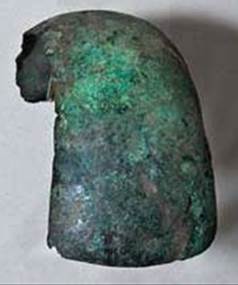
In this dig 92 copper and iron breast plates with skeletons were found as shown in the picture.
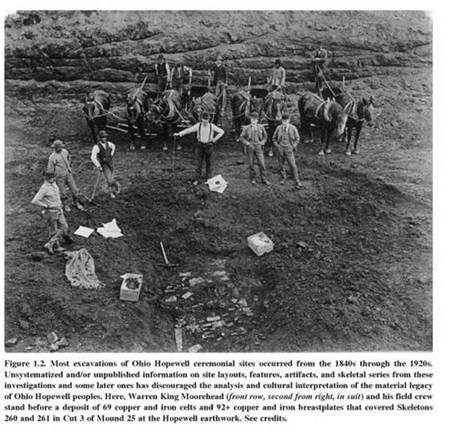
Swords
The Book of Mormon mentions swords. Swords were found in Indian Hopewell mounds by early American settlers. Modern archeology has not confirmed the use of iron smelting by Hopewell Indians or swords; they have confirmed woven cloth copper breast plates, meteoric iron tools, copper and silver jewelry and copper tools. Why modern day archaeology has not confirmed iron swords can be explained by two things:
1. The description of the iron swords are of an extreme state of oxidation. Some of the swords had nothing left but the handle and iron oxide left for the blade.
2. When some swords were found early settlers assumed it to be of European manufacture and not of the native aborigines. Most researchers believed that aborigines did not make iron tools. The Hopewell and Adena have proven they did make and use metal tools and weapons. In these cases listed below many of the swords were found in graves of the mound builders.
Alma 44:18
18 But behold, their naked skins and their bare heads were exposed to the sharp swords of the Nephites; yea, behold they were pierced and smitten, yea, and did fall exceedingly fast before the swords of the Nephites; and they began to be swept down, even as the soldier of Moroni had prophesied.
Mosiah 8:11. In reference to Jaredite swords
11 And again, they have brought swords, the hilts thereof have perished, and the blades thereof were cankered with rust;
“In digging the Louisville canal, nineteen feet below the surface, with the coals of the last domestic fire upon them, medals of copper and silver, swords and other implements of iron. Mr. Flint assures us that he has seen these strange ancient swords.”
(Conant, pg. 111, 1879)
(Items found in Hopewell Indian Ruins)
“A few miles from the town of Columbia, in Maury county, in West Tennessee, and on Duck river, are a number of fortifications, … also, several fragments of earthen ware, and a sword about two feet long, differing from any in use since the white people visited the country, apparently once highly polished, but now much eaten with rust. Those who buried these articles there, could fashion the sword, and could make bricks, and use them by the masonic art.”
(Haywood 1823, pg. 179)
(The sword at this site was found in the state of New York by Smithsonian Researchers)
“Engravings of the silver-plated discs and also of the embossed silver plate sup-posed by Dr. Hildreth to have been a sword ornament, are herewith presented. These articles have been critically examined, and it is beyond doubt that the copper “bosses” are absolutely plated, not simply overlaid, with silver. Between the copper and the silver exists a connection, such as, it seems to me, could only be produced by heat…. Again, if Dr. Hildreth is not mistaken, oxydized iron, or steel, was also discovered in connection with the above remains ; from which also follows, as a necessity upon the previous assumption, the extraordinary conclusion that the mound-builders were acquainted with the use of iron,”
(Squier, pg. 87)
(Items found in Hopewell Indian Ruins)
“On the back side, opposite the depressed portion, is a copper rivet or nail, around which are two separate plates, by which they were fastened to the leather. Two small pieces of the leather were found lying between the holes of one of the bosses. They resemble the skin of an old mummy. The plates of copper are nearly reduced to rust. Around the rivet of one of them is a quantity of flax or hemp in a tolerable state of preservation. Near the side of the human body was a plate of silver, the upper part of a sword scabbard, six inches long, two wide, weighing one ounce. Three longitudinal ridges were on it, which perhaps corresponded with the edges or ridges of the sword.”
(Haywood 1823 pg. 347)
(An iron sword was found in a North Carolina mound. Due to this item Cryus Thomas who believed that the mounds were built after the Europeans arrived. We know the Hopewell mounds were built before Columbus)
“The iron implements which are alluded to in the above-mentioned articles also in Science, as found in a North Carolina mound. “
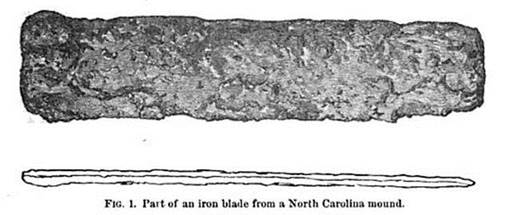
(Cyrus Thomas 1889 pg. 31)
(Items found in Hopewell Indian Ruins)
“The iron was considerably oxidated, and when exposed to the air, dissolved and fell into small particles of rust, leaving only the handle, which was thick, and central parts adhering together. There were four or five of these swords, if we may so call them. The handle was round and cylindrical, and encircled with ferules or rings of silver.”
(Haywood 1823 pg. 328)
(Items found in Hopewell Indian Ruins)
“The aborigines had some very well manufactured swords and knives of iron, and possibly of steel.”
(Haywood 1823 pg. 349)
(Items found in Hopewell Indian Ruins)
“Where the makers of bricks, swords and entrenchments lived, and could not fail to have some surplus commodities to exchange for those foreign coins.”
(Haywood 1823, pg. 177)
Metal Plates
It’s a fact that Hopewell Indian made metal sheets. There are traditional Indian accounts of metal plate being used as records.
Helaman 3:13
13 And now there are many records kept of the proceedings of this people, by many of this people, which are particular and very large, concerning them.
(In reference to Hopewell ruins)
“In Virginia, near Wheeling on Grave creek, is a mound 75 feet high, with many smaller ones around it. In the interior parts of this mound, are found human hones of large size, and mixed with them are two or three plates of brass, with characters inscribed resembling letters.”
(Haywood 1823 pg. 82)
(In reference to Hopewell ruins)
“The shape of the two brass plates, — about a foot and a half in diameter. He said — he was told by his forefathers that those plates were given to them by the man we call God; that there had been many more of other shapes, some as long as he could stretch with both his arms, and some had writing upon them which were buried with particular men; and that they had instructions given with them, they must only be handled by particular people, ….He said, none but this town’s people had any such plates given them, and that they were a different people from the Creeks. He only remembered three more, which were buried with three of his family, and he was the only man of the family now left. He said, there were two copper plates under the king’s cabbin, which had lain there from the first settling of the town. This account was taken in the Tuccabatchey-square, 27th July, 1759, per Will, Bolsover. “
(Adair 1775 pg. 178)
(In reference to Hopewell ruins)
“In the interior parts of this mound, are found human bones of large size, and mixed with them are two or three plates of brass, with characters inscribed resembling letters. A mound near Chillicothe being removed, discovered near the bottom, in a cavity, the remains of some chieftain.”
(Haywood 1823 pg. 82)
(In reference to Hopewell ruins)
“There are certain enchanted beads, certain thin plates of copper, of which extraordinary figures are engraved, with inexplicable words and unknown characters.”
(Haywood 1823 pg. 346)
“According to Morgan, the Muscogee proper, and perhaps also their incorporated tribes, have 22 clans. Of these the Wind appears to be the leading one, possessing privileges accorded to no other clan, including the hereditary guardianship of the ancient metal tablets which constitute the palladium of the tribe.” (Palladium’s meaning in the 19th and 18th century: for safety)
(Mooney 1902 pg. 499)
“To support their pretensions, this family hold in their possession a circular plate of virgin copper, on which is rudely marked indentations and hieroglyphics denoting the number of generations of the family who have passed away since they first pitched their lodges at Shaug-a-waum-ik-ong and took possession of the adjacent country, including the Island of La Pointe or Mo-ningwun-a-kaun-ing… The old chief kept it carefully buried in the ground, and seldom displayed it.”
(Williams, pg. 63)
“Above these is the arch of the heavens, with Roman numerals and Arabic figures scattered through and above it. The figure eight is repeated three times, the letter O repeated seven times. With these familiar characters are ethers which resemble letters of ancient alphabets, either Phoenician or Hebrew.”
(Peet 1892, pg. 45)
Pictured below is a tablet of unknown characters from Stephen D Peet’s book The Mound Builders Their Work and Relics.

Metal Bow
Nephi had a steel bow. Some of the swords found be early settlers were believed to be iron or steel. Here is an early account of finding a steel bow.
“I have been told by an eye witness, that a few years ago, near Blacksburgh in Virginia, eighty miles from Marietta, there was found about half of a steel bow, which, when entire, would measure five or six feet; the other part was corroded or broken. The father of the man who found it was a blacksmith, and worked up this curious article, I suppose, with as little remorse as he would an old gun-barrel. Mounds are very frequent in that neighbourhood, and many curious articles of Antiquity have been found there.”
(Atwater 1833, pg. 176)
“A few years ago, near Blacksburg in Virginia, 8 (5 miles from Marietta, was found about the half of a steel bow, which when entire would have measured five or six feet.”
(Haywood 1823, pg. 349)
Coins
Archeologist have not found coins yet but I believe that settlers went through the mounds and areas and picked up items of value as did John Haywood and others. For the most part, I believe that any unknown or strange coins found by settlers or historians would not have been attributed to Native American manufacture.
Haywood and Atwater found coins in Hopewell Indian mounds. Haywood believed the mound builders traded their swords and metal work with Romans during ancient times receiving in their place Roman coins.
(Concerning Hopewell Indian artifacts)
“Reasonable to conclude that a civilized race of men once lived on Elk and Duck rivers, who carried on commerce, used coined money, and forged iron into tools. And, moreover, had intercourse with nations who had at least commercial connexions, mediately or immediately, with the Roman Empire.”
(Haywood 1823, pg. 177)
“Where the makers of bricks, swords and entrenchments lived, and could not fail to have some surplus commodities to exchange for those foreign coins.”
(Haywood 1823, pg. 177)
“Of all the Roman coins that have been found in Tennessee and Kentucky, the earliest bears date in the time of Antoninus, the next in the time of Commodus.”
(Haywood 1823, pg. 183)
“First. On the farm of Mr. Edward Payne, near Lexington, were found two ancient coins; one was of gold, and sold for 13 dollars: the other was of brass. Each had a head reversed, and both were inscribed with characters not understood, but said to resemble Hebrew. The date of the gold coin was probably 1214, and the date of the brass piece 1009.”
(Haywood 1823, pg. 343)
“Several Roman coins, said to have been found in. a cave near Nashville, in Tennessee, bearing date not many centuries after the Christian era, have excited some interest among Antiquarians.”
(Atwater 1833, pg. 119)
“In Harrison County, I have been credibly informed, that several coins were found, near an ancient work.”
(Atwater 1833, pg. 118)
“When to these are added the considerations inseparable from other like instances, in the neighbourhood of Tennessee, where strange coins have been found, some with superscriptions in unknown characters.”
(Haywood 1823, pg. 178)
“Mr. Spear found under the roots of a beech tree which had been blown up, two pieces of copper coin, of the size of our old copper pence. On one side was represented an eagle, with three heads united to one neck.”
(Haywood 1823, pg. 179)
“At Circleville a copper coin was taken from the central mound, from beneath the roots of a hickory growing on the mound, seven or eight inches in circumference. It has no resemblance in its devices to any British or other coins to which it hath been compared.”
(Haywood 1823, pg. 342)
“Above Hillsborough in North Carolina, and near the remains of a town which had been deserted in very remote times, was picked up, about the year 1805 or 1804, a round piece of copper about the size of an American eagle. On both sides was a short line of letters, with parallel lines increasing in length till past the center, whence they decreased in length to the bottom, accommodating themselves to the rounded shape of the copper. It was neatly executed. The letters were of some unknown alphabet. This copper was dropped again on the same plantation, where probably it now is.”
(Haywood 1823 pg. 343)
Mound Fortifications
Hopewell/Nephite Indians built mound fortifications as a defense against invading Indian tribes. The Hopewell civilizations matches the Book of Mormon not only because of the timeline, but because of earthen mounds around all their cities, as stated in Alma 50:1.
Alma 50:1
1 And now it came to pass that Moroni did not stop making preparations for war, or to defend his people against the Lamanites; for he caused that his armies should commence in the commencement of the twentieth year of the reign of the judges, that they should commence in digging up heaps of earth round about all the cities, throughout all the land which was possessed by the Nephites.
Alma 49:4
4 But behold, how great was their disappointment; for behold, the Nephites had dug up a ridge of earth round about them, which was so high that the Lamanites could not cast their stones and their arrows at them that they might take effect, neither could they come upon them save it was by their place of entrance.
Alma 50:2–4
2 And upon the top of these ridges of earth he caused that there should be timbers, yea, works of timbers built up to the height of a man, round about the cities.
3 And he caused that upon those works of timbers there should be a frame of pickets built upon the timbers round about; and they were strong and high.
4 And he caused towers to be erected that overlooked those works of pickets, and he caused places of security to be built upon those towers, that the stones and the arrows of the Lamanites could not hurt them.
Description of the Hopewell Pollock Stockade
“It consists of a series of earthen embankments ranging from three to ten feet in height that partially enclose a large, 120-acre, plateau located along Massie Creek.
“Robert Riordan, an archaeologist with Wright State University, has directed many seasons of excavations at the Pollock Works revealing a complicated site history. The works appear to have been constructed in five major stages beginning as early as AD 50. One of these stages involved the erection of a large, timber stockade along the top of the earthen embankments.”
When Squier described this site he said with a simple stockade this site would be impregnable. He did not know but archaeological excavation showed that at one time the Pollock Works did have a timber stockade.
I could not find a reconstruction of Hopewell Indian stockade but did find a reconstructed stockade at Angel Mounds. The stockade show below dates past the Book of Mormon and Hopewell timeline to 1100AD-1450AD. I can only assume the building of defensive structures continued to be built by the Lamanites until the practice of building fortresses eventually died out altogether:
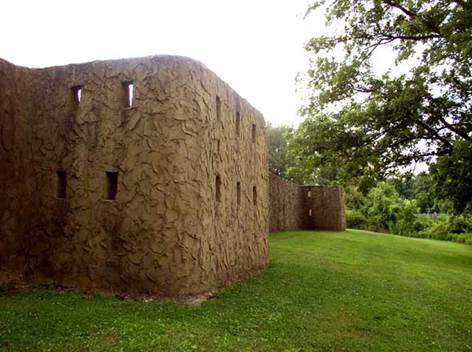
Angel Mound
“Archaeological excavation revealed that the town was surrounded by a stockade, with the Ohio River acting as a barrier on the south side. A gateway was placed to the east, about a fourth of the way around from where the eastern flank of the stockade meets the river. A second barrier, a type of picket fence, was set 14 feet (4.3 m) outside the stockade. It was designed to slow the attackers as they came into range.
In 1972 the park reconstructed part of the stockade, based on archaeological evidence. It stands 12′ high and is made of wooden posts set 4 feet deep into a narrow trench. The posts are covered with wattle and daub, a loose weaving of sticks covered with a mud-and-grass plaster. The defensive bastions were also reconstructed, which had been built every 10 to 11 feet (3.4 m) and projected 11 to 12 feet (3.7 m) from the wall. The original people planned the bastions at distances which defenders could cover with arrows or lances, thus protecting the walls from a direct attack.”
“From one of these to another is about two arrowshot; so that the archers in the towers would be able to defend the whole distance of the wall between them; while those in front could ward off the assailants at the passage”
(Thaddeus Mason Harris, The Journal of a tour into the Territory Northwest of the Alleghany Mountain; 1805)
“Col. M. asked him if he could not tell who made those old forts, which displayed so much skill in fortifying. He answered that he did not know, but that a story had been handed down from a very long ago people, that there had been a nation of white people inhabiting the country who made the graves and forts.”
(M.H. Frost 1819; On the aborigines of the Western Countries)
“John Cushen, an Indian of truth and respectability, having pointed to the large mound in the town of Chillicothe, observed to a gentleman that it was a great curiosity. To this the gentleman accorded, and said, The Indians built that. No, said he, it was made by white folks, for Indians never make forts or mounds — this country was inhabited by white people once.”
(M.H. Frost 1819; On the aborigines of the Western Countries)
Concerning Hopewell Indian Mounds
“In one of the plates of Lapiteau’s work, there is a representation of an attack on an Indian fort, which is evidently constructed upon one of the mounds: its form is circular, the enclosure of large pickets and heavy beams on the outside, extending to the ground on which the mound stands. Those inside defend themselves with stones, arrows, &c. while the assailants are either aiming their arrows at such as appear above the wall.”
(Brackenridge 1811 pg. 185)
“The care which is everywhere visible, about these ruins, to protect every part from a foe without; the high plain on which they are situated, which is generally forty feet above the country around it; …they speak volumes in favour of the sagacity of their authors”
(Atwater 1833 pg. 130)
“Imlay, in his fanciful description of Kentucky, asserts that the Indians were not acquainted with the use of fortifications.”
(Brackenridge 1811 pg. 183)
Alma 48:8
8 Yea, he had been strengthening the armies of the Nephites, and erecting small forts, or places of resort; throwing up banks of earth round about to enclose his armies, and also building walls of stone to encircle them about, round about their cities and the borders of their lands; yea, all round about the land.
“Could bricks be of any use to the ancient inhabitants, without the trowel and the masonic art, not to mention the building of stone walls?”
(Haywood 1823 pg. 189)
Mass Burial Pits and Battlegrounds
Two thirds of the Book of Mormon is about wars between the Lamanites and Nephites. Large bone pits and piles were found in the state of New York and other states. These large bone pits are supportive evidence of the battles that took place between Nephites and Lamanites.
In the last battles Mormon states that bodies of the Nephites were heaped into piles (Mormon 2:15).
New York State:
“It was called the “Bone Fort,” from the circumstance that the early settlers found within it a mound, six feet in height by thirty at the base, which was entirely made up of human bones slightly covered with earth… The popular opinion concerning this accumulation is, that it contained the bones of the slain, thus heaped together after some severe battle.”
(Squier 1849)
Kentucky:
“Half a mile from this place, at the foot of the mountain, in a large cave full of human bones, perhaps several wagon loads; some of which are small, and others very large”
(Haywood 1823 pg. 153)
New York State:
“The bones were of individuals of both sexes and of all ages. Among them were a few fetal bones. Many of the skulls bore marks of violence, leading to the belief that they were broken before burial.”
(Squier 1849)
Illinois:
“Mr. Ramey, the owner of the mound, speaks about digging in one part of the field and finding heaps of bones eight feet deep, and says that the bones are everywhere present.”
(Peet 1892 pg. 163)
New York State:
“Human bones have been discovered beneath the leaves; and in nearly every part of the trench skeletons of adults of both sexes, of children, and infants, have been found, covered only by the vegetable accumulations. They seem to have been thrown together promiscuously.”
(Squier 1849)
New York State:
“Among them may be mentioned the “bone-pits,” or deposits of human bones. One is found near the village of Brownsville, on Black River. It is described as a pit, ten or twelve feet square, by perhaps four feet deep, in which are promiscuously heaped together a large number of human skeletons.”
(Squier 1849)
Cloth and Fine Twined Linen
Anthropologist archeological digs have shown that Hopewell Indians made their own woven cloth.
Helaman 6:13
13 Behold their women did toil and spin, and did make all manner of cloth, of fine-twined linen and cloth of every kind, to clothe their nakedness.
“The relics which are most numerous are spear-heads, arrow-heads, … needles, and occasionally specimens of woven fiber, which might have formed the clothing for a rude people, and a few specimens of the higher works of art”
(Peet 1892 pg. 25)
Below is an artifact of Hopewell/Nephite cloth:
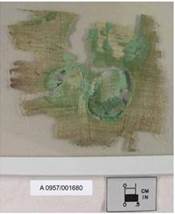
More Hopewell Cloth Artifacts:
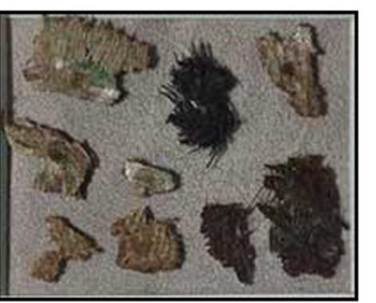
Item (A) Hopewell Necklace and (B) Hopewell Buttons:
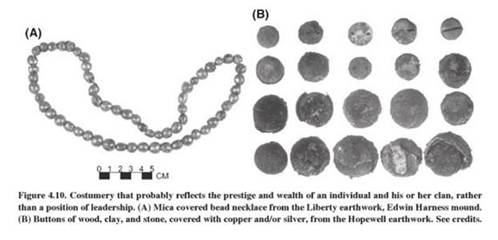
Woven Cloth Worn as Clothing
Hopewell Indian use of woven cloth matches the Book of Mormon description of Nephites wearing woven clothing and in some instances it being described as a status symbol.
4 Nephi 1:24
24 And now, in this two hundred and first year there began to be among them those who were lifted up in pride, such as the wearing of costly apparel, and all manner of fine pearls, and of the fine things of the world.
“Skeleton 248 had been dressed in a skirt of finely woven cloth extending from the waist to the knees, to which had been sewn pearls, bears-teeth, and other ornaments.”
(Moorehead 1922 pg. 169)
“Unarguable Mississippian period representations of garments do exist, and these make credible the interpretation of the burial 103 fabric as a possible garment. For example, Phillips and Brown (1978: Plate 20) illustrate fragments of a Spiro engraved shell cup that depicts male human figures wearing tunics that cover one shoulder and a portion of the chest. One of a group of six human figures engraved on the Rocky Creek limestone slab (Parker 1949:Figure 2) is shown wearing a cloak-like garment that covers the shoulders, one arm, all but the lower part of the other arm, and the entire torso.”
(A Most Indispensable Art: Native Fiber Industries from Eastern North America, by James B. Petersen)
“Equivocal representations of garments over the upper body include two almost identical shell gorgets from Mound C at Etowah, one of which came from the 1884 BAE excavations (Thomas 1894:Figure 190), and the other (unpublished) from burial 19 excavated in 1954 by Larson. The dual human figures have the upper body and arms covered with parallel lines that may represent a garment…”
(A Most Indispensable Art: Native Fiber Industries from Eastern North America, by James B. Petersen)
“The elite nature of the fabric evidence and the burial context warrants such in inference here. Mound C apparently supported a mortuary temple which, in turn served as the focus of an elaborate complex of funerary rituals associated with a high status social group at Etowah.”
(Larson 1971)
Extensive Trade System and Zelph
In May and June 1834 Joseph Smith led a Mormon group (a paramilitary expedition known as Zion’s Camp) on a march from Kirtland, Ohio to Jackson County, Missouri. On June 3, while passing through west-central Illinois near Griggsville, some bones were unearthed from a mound. These bones were identified by Smith as belonging to a Lamanite chieftain-warrior named Zelph. The mound in question is now known as Naples-Russell Mound 8.
“At about one foot deep we discovered the skeleton of a man, almost entire; and between two of his ribs we found an Indian arrow, which had evidently been the cause of his death. Subsequently the visions of the past being opened to my understanding by the Spirit of the Almighty, I discovered that the person whose skeleton was before us was a white Lamanite, a large, thickset man, and a man of God. His name was Zelph. He was a warrior and chieftain under the great prophet Onandagus, who was known from the Hill Cumorah, or eastern sea to the Rocky Mountains.” The Hopewell Indians made highways and had an advanced trade system that extended to the Rocky Mountains. Joseph Smith vision of Zelph matches the extensive trade of the Hopewell Indians.
The Prophet Onandagus is not mentioned in the Book of Mormon, but he could have ties to the Onondaga Tribe whose traditional lands are in the state of New York.
Animals
Horses, Chariots, Highways, and Trade
The Book of Mormon mentions horses and chariots. Anthropologist state that North American horses went extinct around 11000 BC. Horse bones dating to 7000 BC were found later. To know exactly when each horse, elephant, and cow went extinct has to be an unsure science. Interestingly, once again it is believed that the Clovis people (who I believe are the same Nephite/Lamanite peoples mentioned in the Book of Mormon) who caused this extinction.
The Hopewell/Nephites had advanced highway trade. The Great Hopewell Road a road made by the Hopewell is 60 miles long from Newark to Chillicothe. Hopewell trade stretched to the Rocky Mountains to the Gulf of Mexico. This is known because obsidian Hopewell artifacts in plentiful supply are from the Rocky Mountains from New Mexico to Montana. It might have also stretched to Central and South America. Jaguar teeth and slanted eye figurines more common to central and South America by the Mayans were found at the Mann Hopewell site in Indiana.
The questions becomes: did the Hopewell travel thousands miles to the Gulf Coast and to the Rocky Mountains and beyond carrying supplies and commodities by hand and foot? I would contend it was by horse and chariot. It seems implausible that their extensive and advanced trade system could be maintained without horse and chariot.
Just like Nephi brought over metallurgy, breastplates, swords, coins, and cloth technology, why not also the use of horses and chariots?
It is a known fact that man had interaction with horses. Pre-Columbian Clovis spear points were found in Colorado that had horse protein on the spear point.
http://www.academicroom.com/article/identification-horse-exploitation-clovis-hunters-based-protein-analysis
https://en.m.wikipedia.org/wiki/Clovis_spear_points
(In reference to a petroglyph found in Massachusetts)
“In another scene, there is a vessel, with its masts, flags, and long rudder, as in the oriental vessels at this day. There is the figure of a horse, which is the well-known symbol of Carthage.”
(Haywood 1823 pg. 329)
Elephants/Mammoths
The Book of Mormon mentions elephants. There is both archeological evidence of human interactions of Mammoths and Indian legend of Mammoths. When Haywood was going through the mounds in his area he assumed that the Indians were raising mammoths because mammoth bones were found among human bones. They also found Indian pipes in the shape of elephants.
In one Iroquois legend about a large beast that caused havoc in a village. David Cusick attributes this beast to being a mastodon.
Man hunting mammoths has been confirmed by archeologist. It is believed by some scientist that human hunting caused the Mammoth to become extinct.
“The Naco Mammoth Kill Site is an archaeological site in southeast Arizona, near Naco, Arizona. The site was reported to the Arizona State Museum in September 1951 by Marc Navarrete, a local resident, after his father found two Clovis points in Greenbush Draw, while digging out the fossil bones of a mammoth. Emil Haury excavated the Naco mammoth site in April 1952. In only five days, Haury recovered the remains of a Columbian Mammoth that had been killed by the use of at least 8 Clovis points…“
(Concerning items found in a Hopewell mound)
“The fourth discovery consisted of a carved stone pipe, also in the shape of an elephant or mastodon.”
(Peet 1892 pg. 163)
Elephant pipe depictions are from The Mound Builders Their Work and Relics by Stephen D Peet PhD.

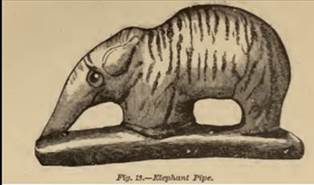
“The latter (necklace) may have been produced in America, but the ivory beads most probably came from India; or the country in its vicinity, where the elephant is raised, and the ivory worked.”
(Haywood 1823, pg. 82)
“At the time they found the grave above mentioned, they also found other graves, and small pieces of decayed human bones, and bones of animals, amongst which was the jaw bone with the tusk attached to it, of some unknown animal. The jaw bone is about a foot long, having at the extremity a tusk one inch and a half in length. The tusk is in the same form as that of Cuvier’s mastodon, but has more curvature.”
(Haywood 1823 pg. 126)
Cattle
Book of Mormon mentions cattle which is a criticism for the Book of Mormon saying there is no proof. It’s a known fact that three species of cattle (Bison latifrons, Ovibos cavifrons, Bison antiquus,) roamed what is now Hopewell Indian lands. It’s believed that the Clovis people once again caused the extinction of these animals. Any animals that became extinct by the Clovis people will be attributed to the Nephites in this essay. The generally accepted theory of the Clovis spear point does not match up with the Book of Mormon ‚but as I stated previously, the current theories of the Clovis people are put into question with the given archeological, linguistic, cultural and DNA evidence.
“But specimens (Ovibos cavifrons) of this species have been excavated in Louisiana, Mississippi, Tennessee, and Virginia; suggesting the southern limits of its range probably extended into the Georgia piedmont.”
Goats
An indigenous species of goat the Harington goat lived on the American continent but went extinct with the other 25 animals. I believe that the Clovis people (Nephites and Lamanites) caused its extinction.
Below is a Hopewell goat horn copper artifact.
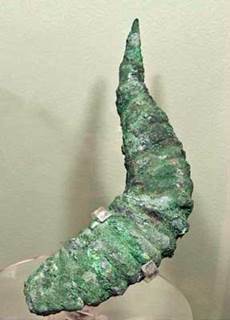
Sheep
Sheep are mentioned by the Jaredites but the Nephites only mention sheep in parable. I believe the Jaredites brought over sheep but during times of famine as stated in the Book of Ether there sheep became extinct (Ether 10:1, Ether 11:7). In the book of Enos chapter 2:21 it mentions types of animal the Nephites raised and flocks that they had. It mentions that they had flocks of all manner of cattle but sheep is not mentioned.
21 And it came to pass that the people of Nephi did till the land, and raise all manner of grain, and of fruit, and flocks of herds, and flocks of all manner of cattle of every kind, and goats, and wild goats, and also many horses.
The only time the Nephites mention sheep is in parable. Because of this I’m going to assume that the mention of flocks by the Nephites is in reference only to cattle, goats and horses.
Bees
Book of Mormon mentions bees but bees as of this point are not found in America pre-Columbus. The Book of Mormon states that the Jaredites collected bees then brought them on their ship and sailed to America. Since bees and honey are never mentioned by the Jaredites or Nephites while in the land of promise I’m assuming the bees did not survive the voyage.
Cureloms and Cumoms
Cureloms and Cumoms are two types of animals mentioned in the Book of Mormon by the Jaredites that they considered useful. It’s believed the Clovis people caused 25 different animals to go extinct one can pick and choose from this list which animal best fits this description. It could be a camel indigenous to North America or a ground sloth the size of a bear. Both of these animal went extinct at the same time as the cattle and Harington goat and cameloid protein has been found Clovis spear points. Once again I believe the dating of when every single animal of a particular species went extinct and is incorrect.
Ether 9:19
19 And they also had horses, and asses, and there were elephants and cureloms and cumoms; all of which were useful unto man, and more especially the elephants and cureloms and cumoms.
Barley and Wheat in Hopewell Agriculture
Hopewell Indians were agriculturalist and grew little barley and may grass in my opinion acceptable substitutions for the mention of barley and wheat grown by the Nephites – May grass and wheat are both types of grass seed
Unknown Characters and Language
Mormon 9:34 – But the Lord knoweth the things which we have written, and also that none other people knoweth our language; and because that none other people knoweth our language…
I believe that haplogroup X or the Nephites brought over a distinct language and culture. There is evidence that the Great Lake Indians have a unique and different language from surrounding tribes.
(Gaspesian/Micmac Indians Proposed Nephite/ Hopewell survivors)
“The Gaspesian language has nothing at all in common, in its expressions, any more than in the meaning of its words, with the languages of our Europe ….because, amidst an infinity of different tongues which prevail among all these peoples, our Gaspesians are distinguished from the Montagniez, Soquoqui, Abennaqui, Hurons, Algomquins, Iroquois, and other nations of this new world, by a language which is peculiar to them.”
(Clercq 1680 pg. 141)
(The area mentioned in the quote corresponds with the Gaspesian/Micmac Indians lands the proposed Hopewell/ Nephites survivors)
“A very respectable American author has imagined, that the Indian tribes to the northward of the river Saco spake a language very different from that of the tribes to the southward of the famed river. He informs us, that ”there was not one word” of the language of the tribes of Penobscot and St. John’s, who dwell to the northward of the Saco.”
(Barton pg. LVIII)
“Letters of an unknown alphabet are inscribed upon a rock in the western parts of New-York. There is a rock, called the Dighton rock, on Taunton River, near Dighton, in Massachusetts. It is a large rock in the margin of the sea, and upon it are inscriptions in strange characters, partly alphabetical and partly hieroglyphic.”
(Haywood 1823 pg. 329)
“There are certain enchanted beads, thin plates of copper, of which extraordinary figures are engraved, with inexplicable words and unknown characters.”
(Haywood 1823 pg. 346)
A Lost Book/Gospel
(Concerning Hattera Indians of North Carolina)
“These (Hattera Indians) tell us, that several of their Ancestors were white People, and could talk in a Book, as we do; the Truth of which is confirmed by gray eyes being found frequently amongst these Indians, and no others”
(John Lawson 1709 pg. 62)
(About Gaspesian/Micmac Indians)
“They hold, further, that it could well have been a fact that these individuals were instructed in the sacred mysteries of our holy Religion, and that they had even a knowledge and the use of letters, since, in the establishment of colonies, it is customary to send there men who are alike learned and pious, in order that they may teach to the peoples, along with purely human knowledge, the most solid maxims of Christian wisdom and piety. Nobody, however, having followed them in these glorious employments, the knowledge which they had of the true God, of letters, and of their origin, was thus gradually lost and effaced from the minds of their unfortunate posterity by the lapse of time.”
(Clercq 1680 pg. 86)
(Gaspesian/Micmac Indians)
“These people had received in times past a knowledge of the Gospel and of Christianity, which they have finally lost through the negligence and the licentiousness of their ancestors.”
(Clercq 1680 pg. 86)
(In reference to the North American Indians)
“It is said among their principal or beloved men, that they have it handed down from their ancestors, that the book which the white people have was once theirs. That while they say that their forefathers were possessed of an extraordinary divine spirit, by which they foretold future events, and controlled the common course of nature, and this they transmitted to their offspring, on condition of their obeying the sacred laws. That they did by these means bring down showers of plenty on the beloved people. But that this power, for a long time past, had entirely ceased.”
(Boudinet 1816 pg. 114)
“Colonel M. inquired why the Indians had not learned these arts of the white people. He replied indefinitely, relating that the Great Spirit had once given the Indians a book, which taught them all these arts, but that they had lost it, and had never since regained the knowledge of them.”
(M.H. Frost 1819; On the aborigines of the Western Countries)
According to an old Cherokee quoted by Buttrick:
“God gave the red man a book and a paper and told him to write, but he merely made marks on the paper, and as he could not read or write, the Lord gave him a bow and arrows, and gave the book to the white man.” Boudinot, in “A Star in the West,”‘ quoted by the same author, says: “They have it handed down from their ancestors, that the book which the white people have was once theirs; that while they had it they prospered exceedingly; but that the white people bought it of them and learned many things from it, while the Indians lost credit, offended the Great Spirit, and suffered exceedingly from the neighboring nations; that the Great Spirit took pity on them and directed them to this country,”
(Mooney 1902 pg. 483)
“According to Morgan, the Muscogee proper, and perhaps also their incorporated tribes, have 22 clans. Of these the Wind appears to be the leading one, possessing privileges accorded to no other clan, including the hereditary guardianship of the ancient metal tablets which constitute the palladium of the tribe.” (Palladium in the 19th and 18th century means for safety)
(Mooney 1902 pg. 499)
Hieroglyphs
Anthropologist do not recognize the American Indians as having a written language. The Book of Mormon and traditional Native American accounts and examples hieroglyphic characters speak differently to this assumption. The Book of Mormon says they did have a written language but this ability was lost with the extinction of the Nephites/Hopewell Indians. What was left was hieroglyphs in its most basic form.
There are four Micmac hieroglyph characters found in their Book of Pray that resemble Egyptian Hieroglyphs.
“He proposes in another work to present the customs, beliefs, and rites of the Ojibways as they are, and to give the secret motives and causes thereof, also giving a complete exposition of their grand religious rite, accompanied with the ancient and sacred hieroglyphics pertaining thereto, with their interpretation, specimens of their religious idiom, their common language, their songs. “
(Williams 1885, pg. 5)
“To support their pretensions, this family hold in their possession a circular plate of virgin copper, on which is rudely marked indentations and hieroglyphics denoting the number of generations of the family who have passed away since they first pitched their lodges at Shaug-a-waum-ik-ong and took possession of the adjacent country, including the Island of La Pointe or Mo-ningwun-a-kaun-ing.”
(Williams 1885, pg. 63)
”Yet they have certain hieroglyphics, by which they describe facts in so plain a manner, that those who are conversant with those marks can understand them with the greatest ease, as easily, indeed, as we can understand a piece of writing. For instance, on a piece of bark, or on a large tree with the bark taken off for the purpose, by the side of a path, they can and do give every necessary information to those who come by the same way… although they have not all the same marks; yet I have seen the Delawares read with ease the drawings of the Chippeways, Mingoes, Shaw-anos, and Wyandots, on similar subjects. “
(Heckewelder 1881 pg. 130)
Below is a 1590 depiction of a Native American by Theodore Bry. The symbols shown on the body are marks worn by men to show their affiliation: “whereby it may be known what Prince’s subjects they be, or of what place they have their origin.”
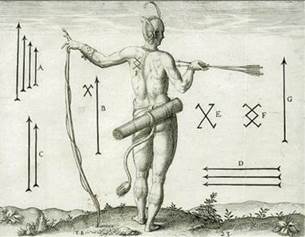
Micmac Characters
Father Chretian Le Clercq a Roman Catholic missionary lived among the Micmac Indians for twelve years. After spending this time with the Micmac, he then sailed back to France and wrote a book about the customs and religion of the Micmac Indians.
He helped the Micmac Indians develop a written language composed of Hieroglyphs. He most likely used the characters that the Micmac Indians were already familiar with. If Clercq himself had developed the written language he most likely would have used the Latin alphabet — the language he grew up reading and writing with.
Four Micmac characters are similar to Egyptian Hieroglyphs in appearance and meaning. Other Micmac characters are similar to characters found on the Anthon Transcript.
The Anthon Transcript is the piece of paper on which Joseph Smith transcribed characters from the golden plates so that he could show Dr. Charles Anton. Anton was an Egyptologist that was confirm the validity of the golden plates translation. Per the history, Anton described the characters as Egyptian, Chaldean and Assyrian.
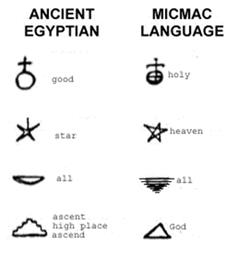
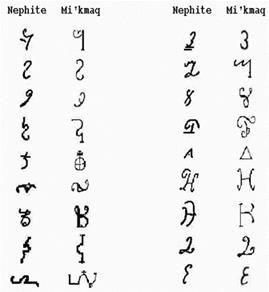
Chaldean

In all likelihood, a “reformed Egyptian” would include Egyptian hieroglyphics and Chaldean characters.
Michmash
In the Old Testament there is a city that still exist today known today as Mikhmas and known in the Old Testament as Michmash. In the Old Testament the pronunciation of Michmash is very similar to the name of the Micmac tribe. Based on their similar beliefs and their Book of Prayers characters, I believe the Micmac tribe are direct descendants of the Nephites/Hopewell Indians and survived the Nephite genocide by escaping to the North. Their geographical location above the hill Cumorah and other factors such as a nomadic lifestyle, being decimated by sickness, as well as wars with the Iroquois, offers more evidence to support this conclusion. Based on the Iroquois beliefs and traditions, the Iroquois are the best candidate to be primarily responsible for the extinction of the Nephites.
Michmash in Hebrew means “something hidden”. During the Nephite genocide any surviving Nephites would have to join the Lamanites or hide. The very name of Micmac, if related to Michmash, testifies of this.
Hebrew and Greek language comparisons
There are examples of Hebrew customs, characters, beliefs and language among Native Americans. According to Mormon, they knew how to write in Hebrew and of course had Hebrew customs and beliefs (Mormon 9:33). The Greek language is also compared to the Native American languages of the Indians.
“Antipas – name of a general in the BoM (Alma 56); name of a mountain in the BoM (Alma 47:7, 10); It is a Greek name, an abbreviation for ‘Antipater.’
Archeantus – Nephite commander (Moroni 9:2); a typical Greek formation, made using the Greek prefix ‘arch-‘ (“great, chief”), as in the Biblical Greek names Archelaus and Archippus.
Judea – the name of a Nephite city (Alma 56, 57); it is the Greek (i.e., New Testament) form of the Hebrew name ‘Judah,’ referring to the tribe, the Southern Kingdom, and the area of southern Palestine occupied by the tribe of Judah (the Jews).
Angola – city name at Mormon 2:4 – Greek ‘angelos’, meaning ’angel’”
Mormon 9:33 – And if our plates had been sufficiently large we should have written in Hebrew; but the Hebrew hath been altered by us also; and if we could have written in Hebrew, behold, ye would have had no imperfection in our record.
Creek Indians also had similarities to the Hebrew language. Considering that Nephites became Lamanites and Lamanites became Nephites this is not surprising:
“The name of the Creeks for man, is ishto, and so it is in Hebrew…The same remark might be made with respect to the word Kenaai, for Canaan. Jehovah they call Y‑he-ho-wah. The roof of the house they call toubanora; in the Hebrew it is debonaour. The nose they call nichiri in Hebrew, neheri. The great first cause, Yo-hewah; in Hebrew, Jehovah. Praise the first cause, in their language, halleluwah; in Hebrew, hallelujah. Father they call abba; the same in Hebrew. Now they call na; in Hebrew, na. To pray they call pliale; in Hebrew, phalae. In their language, abel is manslaughter; the same in Hebrew. Wife, awah; in Hebrew, eve, or eweh. Winter, kora in Hebrew, cora. God, Ale; in Hebrew, Ale, or Alohini. A high mountain, ararat; the same by the Indians of Penobscot.”
(Haywood 1823 pg. 282)
Silas T Rand knew several languages to include Hebrew concerning Micmac Indians:
“There are also some words in the language which resemble Greek. The Micmac word Ellenu, an Indian, is not very different from Hellene, a Greek. Ellenu esit (“He speaks Micmac”) is strikingly like the Greek, hellenizei (“He speaks Greek”). But in other respects the language resembles the Hebrew, especially in the suffixes by which the pronouns are connected in the accusative case with the verb.”
(Silas T Rand 1893)
“Their languages are very diverse and differs as much from one another as Dutch, French, Greek and Latin. Declension and conjugation resemble those in Greek, for they, like the Greeks, Have duals in their nouns and even augments in their verbs.”
(In Mohawk Country: Early Narratives About a Native People)
“Shilu in Indian is the same as Shiloh in Hebrew; the Indian word for father is Abba; the word for “waiter of the high priest” is Sagan in both Indian and Hebrew; the word for man in Indian is Ish or Ishie.”
(Adair 1735)
Gaspesian/Micmac Indians:
“Our Indians agree with the Greeks and Latins in this, that they use always the singular, and almost never, or at least very rarely, the plural, even when they speak to their missionaries, or to some other person of prominence. They express themselves by the word kir^ which means “thou,” whether it is the child speaking to its father, the wife to her husband, or the husband to his wife.”
(Clercq 1680 pg. 141)

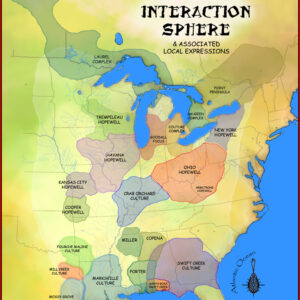
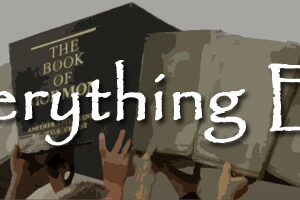
Well written and stated very well, Dave. I enjoyed reading this immensely. I believe also that in times of severe famine (and maybe it’s connected with ancient volcanic activity in places or weather patterns like happened with Tambora and others,) that they may have leaned on what was easiest to find and eat and USE for clothing and such. This would be the horses and Mammoths and other domesticated animals, some of which may have also succumbed to the famine states present at the time.
https://sites.google.com/site/ancientegyptiansinamerica/ancient-egyptians-grand-canyon